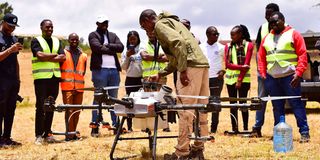Help creatives to leverage 4.0 technologies

A technician assembles a drone during the Kenyan Drone Business Competition (KDBC) that saw 10 finalists interact with international industry experts and drone pilots at Drone Space Training Airfield, Sigoni.
In this era of the fourth industrial revolution, it is difficult to think about the cultural and creative industries (CCI) without proper consideration of the role technology continues to play in the industry.
The fourth industrial revolution is characterised by the “4.0 technologies” such as artificial intelligence (AI), robotics, the internet of things (IOT), 3D printing (additive manufacturing), blockchain, cloud computing, drones and augmented and virtual reality (AR/VR). These technologies present significant opportunities for the production, distribution and consumption of cultural and creative goods and services.
For instance, 3D printing or additive manufacturing can be leveraged in the production of goods, especially at the prototype stages. AI can be used by creatives to understand the consumption habits of their audiences and consequently predict and personalise content.
Drone technology is almost mainstream in the film, photography and videography industry. During Covid, we saw the impressive use of augmented reality in the fashion world to showcase different designs using invisible models.
Virtual reality has also been used for storytelling — transporting audiences to a new world through immersive storytelling. There is even an emerging area of speciality in journalism now known as ‘immersive journalism’. When it comes to how the creative economy can leverage the 4.0 technologies, the possibilities are endless.
National strategies
However, all these remain good ideas on paper, particularly in a developing country, if we do not have proper national strategies and systems to first grow the local creative economy and secondly, support the industry to leverage the 4.0 technologies.
A 2022 report by the United Nations Conference on Trade and Development (UNCTAD) provides three main recommendations for developing nations in order to fully maximize the benefits the industrial revolution technologies within the context of the creative economy.
The recommendations are; developing human capital, fostering an enabling environment and overcoming infrastructure barriers to digitization.
Developing human capital means investing in an education system that equips young people with digital skills and entrepreneurship to prepare them for a decent career within the creative economy. It also means an inclusive system that includes women and minorities such as persons with disabilities and, more importantly, creating a culture of lifelong, progressive learning.
Creating an enabling environment means securing a commitment from the government to introduce policies that encourage investment through incentives, supporting creatives to access capital, as well as laws on competition and intellectual property rights.
Lastly, we must overcome the infrastructure barriers that not only include high-quality connectivity, but also access to other critical infrastructure such as roads, financial services and postal services.
We must also ensure access to digital services by lowering the cost of data and calls to ensure more people — especially youth — are online and exposed to opportunities in the digital world.
Dr Chege is a media, innovation and technology researcher; [email protected]





